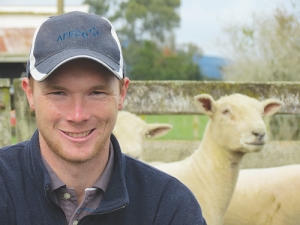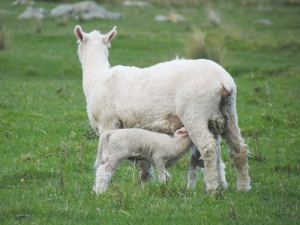By Peter Burke
At just 24 years of age Corey Prouting is making a name as a Southdown stud sheep breeder. While his operation is relatively small he is following in the family tradition as a breeder of excellent terminal sires.
Prouting’s 100HA farm is just north of Levin, in an area of mostly dairying and horticulture, with few commercial sheep operations.
The farm is largely flat and beyond it rise the distant Tararua Ranges, a natural barrier that keeps the area wet, so it handles the summer dry well.
The property has been owned by the family since the 1920s and Corey Prouting is the fifth generation to run the farm. The first owners, his great grandparents, ran mostly Southdown’s. His grandmother started the stud in 1943 and passed it to Corey to manage in 2009.
Since boyhood Prouting showed a great interest in the farm.
“In the weekends I’d help my grandparents on the farm and I enjoyed this. After I left secondary school – Waiopehu College (also Minister for Primary Industries Nathan Guy’s school) – I spent a year doing the farming course at Otiwhiti station in 2009,” he told Rural News.
Once through the Otiwhiti course, Prouting took over managing the Southdown stud. He runs 65 breeding ewes and each year sells about 25 rams to buyers in the North Island. His grandparents started this and he continues.
While Prouting has specific responsibility for the Southdowns, his grandparents run other stud sheep on the farm – Cheviots, Polled Dorsets, Perendales and Romneys and – he helps them with these as well.
The part of the farm where the Southdowns are run was first a dairy farm, but was converted to sheep about 20 years ago. “I like the characteristics of Southdowns: they are very quiet animals, easy to deal with and are good mothers. Their lambs have low birthweights so there are no lambing problems but then they have very quick growth rates,” Prouting explains.
“This allows commercial farmers to get the lambs that have gone to the Southdown ram off the mothers quickly and away to the works.”
This season has been a tough one for all farmers in Horowhenua. There was a lot of rain, frosts came early and the grass has not grown as well as in past seasons. Normally Prouting relies only on grass but this year he had to feed baleage to keep the ewes in good condition leading up to lambing.
“Stud farming entails a lot work and is quite hard because you have to do all the tagging and record keeping,” he says. “But it’s rewarding because you can see the ram hoggets after a year are good sheep and you can show them.”
Showing his stud Southdowns and generally becoming involved in the Southdown Society has been an interest Prouting has pursued since he took over the stud. A few years ago he won the ewe hogget class at the Royal Show at Palmerston North. This year he won the supreme champion ram at the Levin A&P show.
He says showing is good because it enables you to benchmark your stock against others and help think of new ways of managing the stock. But the interest in showing his stock has led to another opportunity – judging.
“I went to the 2014 Royal Show for sheep judging and won the prize for the top junior judge. The prize for winning that was to go to the Sydney Royal show and I went up against competitors from all the Australian states and won a silver medal.”
Prouting is keen to pursue a career as show judge and says he’s had lots of support from the Southdown Society. Last year, they invited him to be junior judge and he’s keen to see where this will lead.
At just 24, Prouting is among the youngest Southdown stud breeders in the country. He’s keen to continue this and is working hard to buy his own farm.



